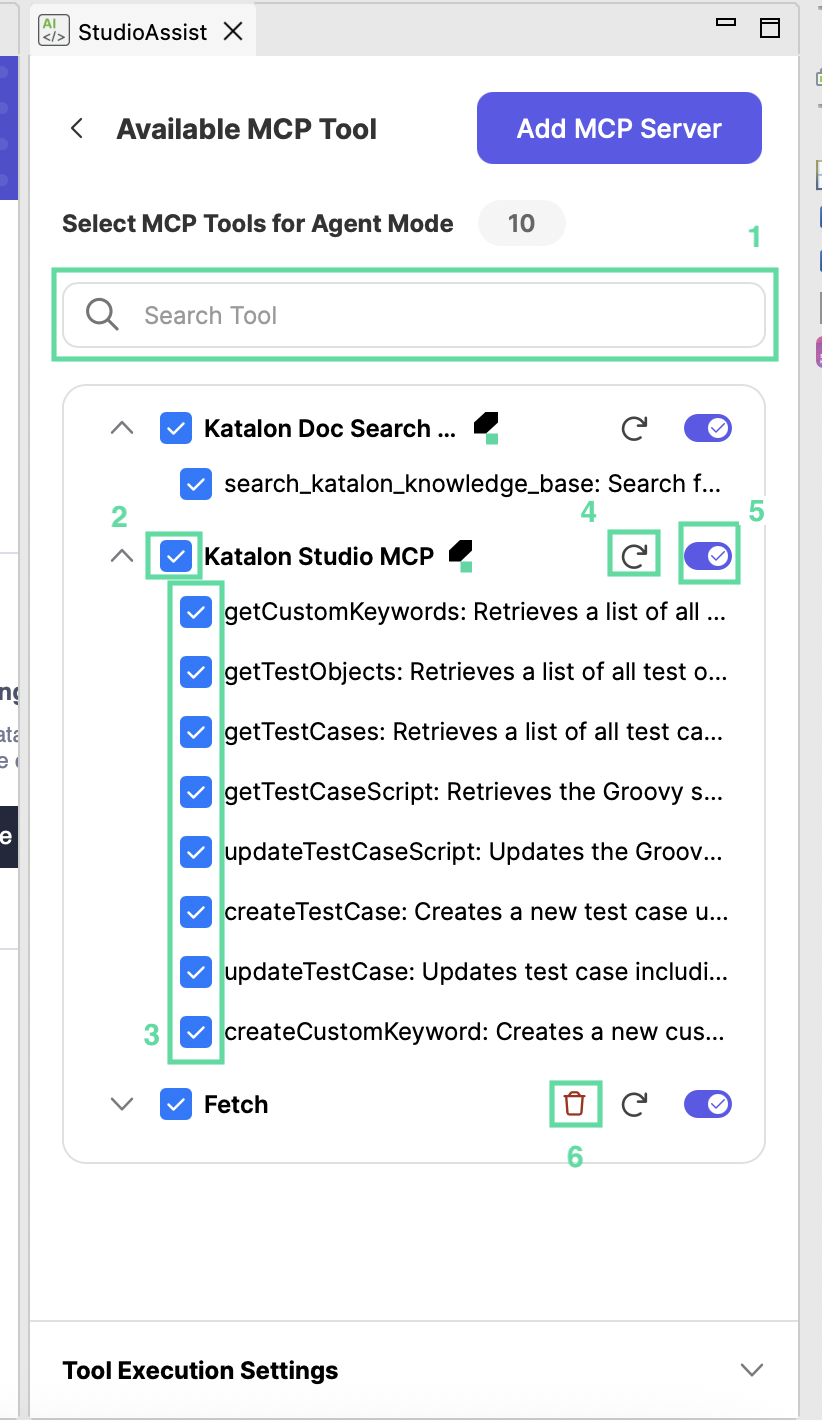MCP Servers and Tools in StudioAssist
This document explains how MCP servers can be helpful, and shows you how to configure MCP servers and their tools in StudioAssist.
Understand MCP servers
An MCP server, or Model Context Protocol server, allows an LLM (Large Language Model) AI model to do more than just generate texts.
Think of MCP servers as a toolbox. When you prompt, they analyze the prompt, find the tools for your AI agent, and then tell it to use these tools for the job. For example, you can ask it to create and write test cases, update Jira tickets, and so much more, just through natural prompting.
Built-in vs. external MCP servers in Katalon Studio
In StudioAssist, we provide 3 Katalon's built-in MCP servers. These servers can help you query Katalon's knowledge base, write/edit test cases in Katalon Studio, and interact with TestOps objects. See Katalon's built-in MCP servers for more details.
Katalon's built-in servers are included and enabled by default. You don't need to do anything further to use our built-in MCP servers.
We also support adding external MCP servers for StudioAssist's AI agent (see Adding external MCP Servers in StudioAssist below for more details). Adding these allows StudioAssist to integrate with these external tools and can help you accomplish more.
Supported transport methods for MCP servers
- StudioAssist currently does not work with servers using STDIO as a transport method.
- Starting version 10.4.0, Katalon Studio supports MCP servers that require authentication (e.g. Atlassian, Linear, Asana, Notion, Webflow... )
Currently, StudioAssist supports MCP servers with SSE or HTTP transport methods:
| Transport method | Execution environment | User type | Input requirement |
|---|---|---|---|
| SSE (HTTP with Server-Sent Event) | Local or remote | Multiple users can access the MCP server | URL to an SSE endpoint |
| HTTP (Modern Streamable HTTP) | Local or remote | Multiple users can access the MCP servers | URL to an HTTP endpoint |
Add an external MCP Server
To add an external MCP server, first click on the setup panel for MCP servers icon next to Agent Mode. This is the the MCP server settings, where you configure MCP servers, their tools, and more.
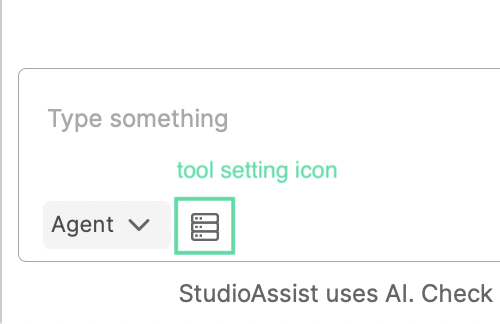
Follow our interactive guide to add an open MCP server (no authentication required):
- Click Add MCP Server. A dialogue Connect to a remote HTTP Server will open.
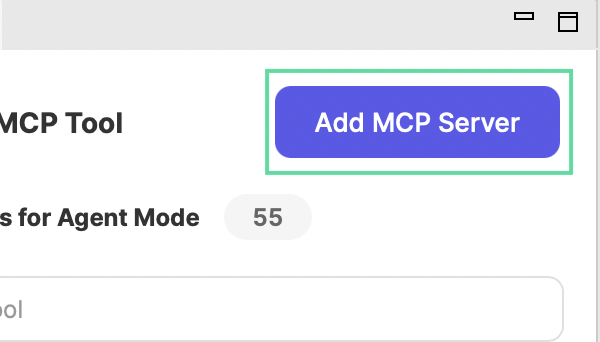
-
Fill in these fields:
- Transport Type: either HTTP or SSE. Your MCP server provider should specify this. You can consider adding these external MCP servers.
- Server URL: the MCP server's URL.
- Name: this name should contain no spaces or special characters (for example, "atlassian-mcp-server"). This name should be unique for the server list, and kept as short as possible (see limitation notes below).
- Title (Optional): the title is the display name of the server. You can have servers with the same name, but we highly recommend giving unique titles to servers.
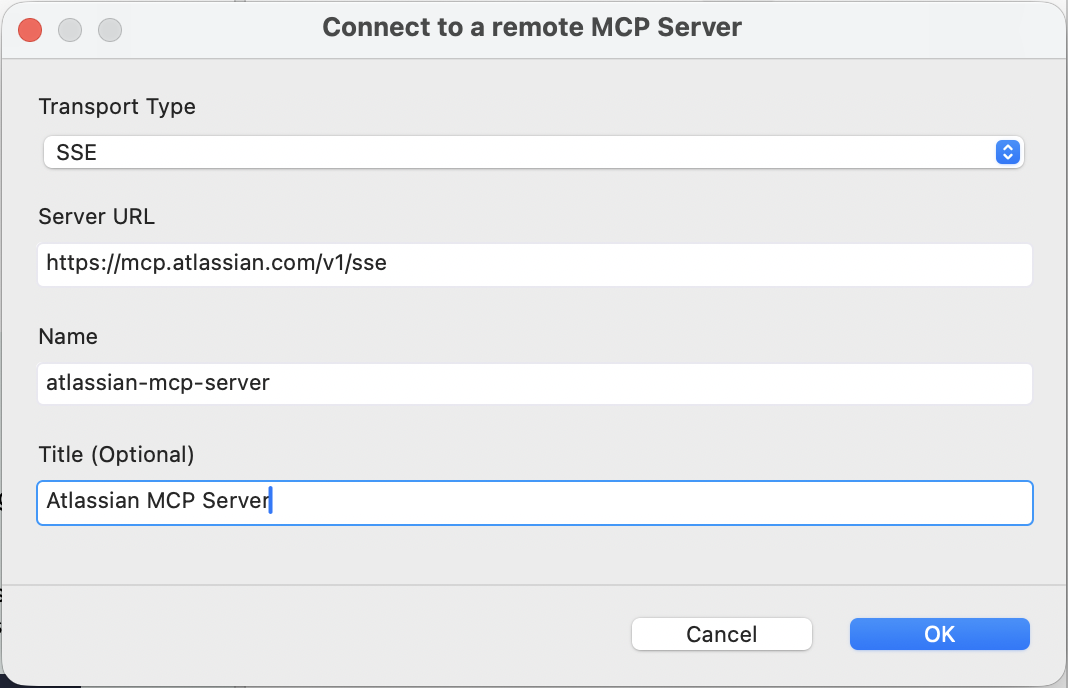
- Click OK. The server loads for a while then expands to display its tool list.
AI providers (OpenAI, Azure OpenAI, Gemini, and AWS Bedrock) enforce a limitation of 64 characters on the combined length of the MCP Server name and tool name ({server_name}_ _ _{tool_name}). Exceeding this limit may cause StudioAssist Agent mode to fail when calling these APIs.
To prevent this, try to keep the MCP Server name (or the tool's name if you host your own server) short, or temporarily disable the tool and revert back later. The Title of the MCP server is not affected by this limit, and can remain as long as needed.
If the MCP server you're adding requires authentication, like Atlassian's MCP server, an icon will display like so.
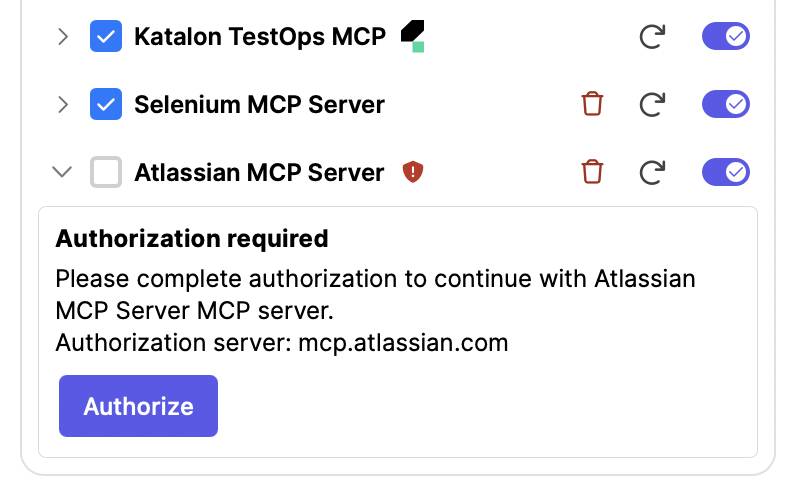
You'll need to click on the server to expand it, and click Authorize. You'll be redirected to the server's authentication site - simply follow through. Once authorized successfully, you can go back to Katalon Studio and see the server along with its tool list.
When a server's token expires, Katalon Studio reminds you to re-grant authorization. Simply click Authorize, and follow the steps above again. If it doesn't load properly due to connection issues, you can reload it with the Reload button.
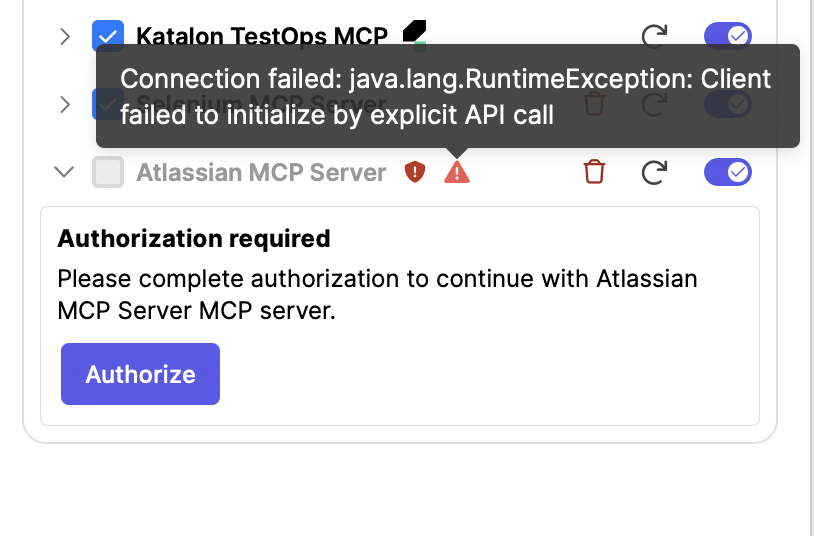
External MCP servers to add to StudioAssist
You can easily add any of the available open MCP servers from the remote MCP servers list.
Please note that some servers on the list require OAuth authentication, which is not yet supported. We plan to include support for these in future updates.
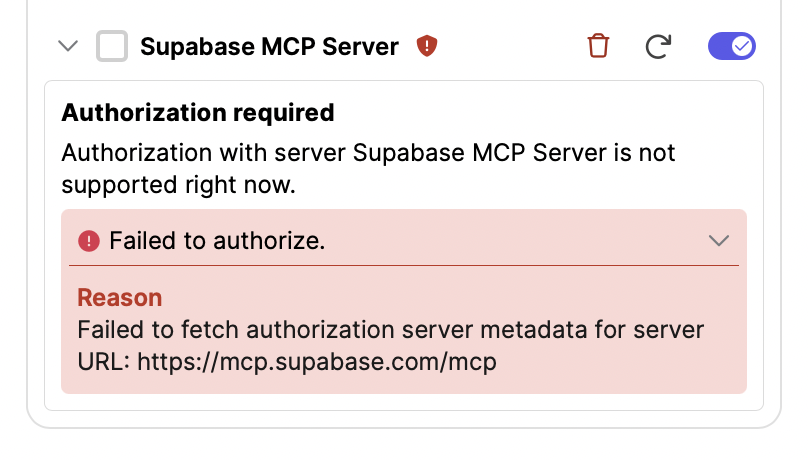
We currently support these OAuth MCP servers below:
-
For project-management purposes: Integrate with these MCP servers to enable StudioAssist to:
- Create and update ticket descriptions automatically
- Read requirements, documentation, and test plans as context for test generation
- Log and create bugs when tests fail
Server Transport type Server URL Atlassian SSEhttps://mcp.atlassian.com/v1/sseNotion HTTPSSEhttps://mcp.notion.com/mcphttps://mcp.notion.com/sseLinear HTTPhttps://mcp.linear.app/mcpAsana SSEhttps://mcp.asana.com/sseAzure DevOps MCP (ADO) HTTPSee setting up instructions at Setting up MCP server for Azure DevOps. -
For testing and automation purposes: Integrate with these MCP servers so StudioAssist can directly interact with browsers and automation tools — enabling test case generation, execution, and debugging.
Server Transport type Server URL Selenium HTTPSee setting up instructions at Setting up MCP server for Selenium. Playwright HTTPSetting up instructions to host this server locally:
1. Host Playwright MCP server withnpxcommand:npx @playwright/mcp@latest --port 8931
2. The server will run locally at http://localhost:8931/mcp. Use this URL to set up connection in StudioAssist. -
For design and prototyping purposes: Connect to these MCP servers to allow StudioAssist to analyze design structures and use design assets as context for generating more accurate and visually aligned test cases.
Server Transport type Server URL Figma HTTPFigma's remote MCP Server URL is currently not supported. As an alternative, you can host the MCP server on your local machine, and connect to this server locally:
1. Open a Figma Design file (latest Figma version).
2. In the toolbar at the bottom, toggle to Dev Mode.
3. In the MCP server section of the inspect panel, click Enable desktop MCP server. A confirmation message will appear once the server is running.
4. The server runs locally at http://127.0.0.1:3845/mcp. Use this URL to set up connection in StudioAssist.Webflow SSEhttps://mcp.webflow.com/sse -
For deployment and hosting purposes: Connect to these MCP servers so StudioAssist can assist with deployment-related actions, such as monitoring, fetching logs, and managing hosted applications.
Server Transport type Server URL Heroku HTTPhttps://mcp.heroku.com/mcp
Manage MCP servers and tools
In the settings menu, you can:
-
(1) Search for an MCP tool
-
(2) Enable all/Disable all MCP tools in a server
-
(3) Enable/Disable an MCP tool: disabling a tool means the AI agent won't use the tool.
-
(4) Reload an MCP server: reload an MCP server to fetch its up-to-date tools.
-
(5) Connect/Disconnect an MCP server: StudioAssist keeps the server's information, but no longer maintains a connection to it.
-
(6) Remove: StudioAssist removes an MCP server and its tools from the list. This helps with de-cluttering - you can always add them back later if needed.
